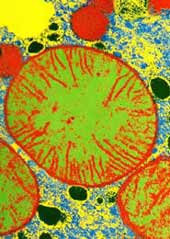Cells’ generators star in action movie

The star of the show: mitochondria. <br>© SPL <br>
American Society for Cell Biology Meeting, Washington, December 2001
Microscope captures mitochondria bopping to a beat.
An intricate mesh of tubes wiggle, worm-like across the screen. “They’re speeding,” says Tim Richardson proudly, watching mitochondria, the cell’s energy generators, zoom around the cell. His controversial microscopic method is shooting the cell’s innards as they’ve never been seen before.
Live cell imaging has revolutionised cell biology over the last 5 years. Using fluorescent labels, proteins can be tracked and filmed in real time. But the lasers used to make the dyes fluoresce exhaust them within seconds and damage or kill living cells.
Six years in the making, Richardson and his colleagues at the Hospital for Sick Children in Toronto, Canada have developed a new technique for peering inside the cell. Their movie, ’Dance of Mitochondria in the Living Cell’ is drawing audiences at this week’s the American Society for Cell Biology meeting in Washington DC.
“I’ve not seen anything like that before,” says Andrew Waterfall, director of microscope imaging company Improvision based in Coventry, UK. A high resolution technique that keeps cells happy is “the holy grail of microscopy,” he says.
Methods which harm the cell make the validity of observations questionable. “Lots of people’s biological research has gone as far as current light microscopy can see,” says Waterfall.
Bopping to the beats of a customised classical soundtrack, mitochondria, the rigid rods of textbook biology are exposed. The speedy shape-shifters sprint across the cell in as little as 5 seconds. “We weren’t expecting to see mitochondria moving,” says Richardson. The network of interconnecting filaments also randomly branch and fuse.
Defective mitochondria implicated in inherited diseases, such as childhood fatal condition Leigh’s syndrome, cannot suck up fluorescent dyes and were previously inscrutable. In these patients, Richardson’s technique shows, the mitochondrial filaments are thicker or spherical and static.
Whether these mobility problems contribute to the symptoms of the disease, or are a byproduct of underlying metabolic problems in mitochondrial proteins, is unclear. “We’re trying to interface between clinical and basic science,” says team member Nu-An Pham.
Sceptics have questioned whether the movements are spontaneous, however. Mitochondrial ’dance’ might be a passive side-effect of movement in the cytoplasm, or even created by the heat of powerful lamps, points out mitochondria researcher Robert Balaban of the National Institutes of Health in Bethesda, Maryland.
Some evidence does suggest that mitochondria move to areas in the cell where most energy is needed. “That would be intriguing,” says Balaban.
Existing light microscopes have trouble capturing transparent structures such as mitochondria, or making out finer details. Richardson’s ’Real-Time Microscopy’ uses light to produces images at a resolution of 200 nanometres, twice that of existing light microscopes and able to capture the 500 nanometre mitochondria with ease. Movies are captured on broadcast quality recorders. “It’s hugely expensive”, admits Richardson.
The team, however, are cagey about the details of their technique until they are patented, describing them only as “beyond” existing techniques. The hush-hush attitude has raised hackles. “Not to show the results is inappropriate,” says Balbaban.
In future, Richardson hopes to use the technique to shoot videos of many cell types and micro-organisms in action
Media Contact
More Information:
http://www.nature.com/nsu/011213/011213-12.htmlAll latest news from the category: Life Sciences and Chemistry
Articles and reports from the Life Sciences and chemistry area deal with applied and basic research into modern biology, chemistry and human medicine.
Valuable information can be found on a range of life sciences fields including bacteriology, biochemistry, bionics, bioinformatics, biophysics, biotechnology, genetics, geobotany, human biology, marine biology, microbiology, molecular biology, cellular biology, zoology, bioinorganic chemistry, microchemistry and environmental chemistry.
Newest articles

“Nanostitches” enable lighter and tougher composite materials
In research that may lead to next-generation airplanes and spacecraft, MIT engineers used carbon nanotubes to prevent cracking in multilayered composites. To save on fuel and reduce aircraft emissions, engineers…

Trash to treasure
Researchers turn metal waste into catalyst for hydrogen. Scientists have found a way to transform metal waste into a highly efficient catalyst to make hydrogen from water, a discovery that…

Real-time detection of infectious disease viruses
… by searching for molecular fingerprinting. A research team consisting of Professor Kyoung-Duck Park and Taeyoung Moon and Huitae Joo, PhD candidates, from the Department of Physics at Pohang University…





















